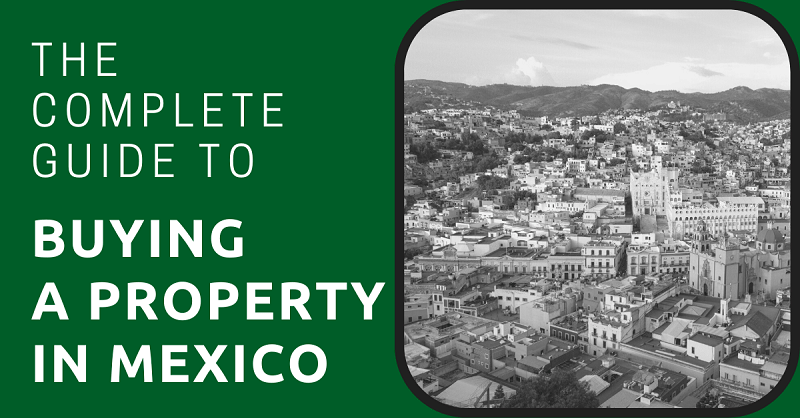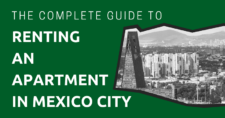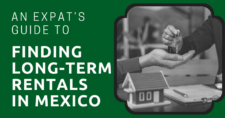
In Mexico, there are numerous hidden gems where life is simple and property prices are low, even though there are also many neighborhoods with high housing demand.
Additionally, in Mexico, the ongoing global trend of human migration from rural areas, such as farms and small villages, to metropolitan areas remains robust. Similar to other prosperous nations, this migration pattern has led to gradual and incremental real estate inflation, primarily fueled by urban expansion.
The exceptions to this pattern are popular expat destinations like Mexico City and Tijuana, where housing prices have doubled (or more) in the past decade. Most large Mexican cities, such as Puebla and Guadalajara, are much less popular with expats and show slow yet steady growth.
In this comprehensive guide, I’ll discuss some vital information about what to expect, what to watch out for, and what you’ll need when buying residential property in Mexico.
This article will take approximately 34 minutes to read. Don't have the time right now? No worries. You can email the ad-free version of the article to yourself and read it later!
Disclaimer: This article may include links to products or services offered by ExpatDen’s partners, which give us commissions when you click on them. Although this may influence how they appear in the text, we only recommend solutions that we would use in your situation. Read more in our Advertising Disclosure.
Contents
- Can a Foreigner Buy a Property in Mexico?
- Requirements for Expats
- Neighborhood
- Types of Property
- Finding A Property
- Obligatory Government Property Appraisals
- Buying Process
- Property Taxes and Extra Costs to Expect
- Ongoing Taxes and Fees
- How Long Will All This Take?
- Do I Need a Lawyer?
- Do I Need a Real Estate Agent?
- Do I Need Title Insurance?
- Do I Need to Speak Spanish?
- Restrictions and Limitations
- Buying Restricted Properties with a Land Trust
- Now, on to You
Can a Foreigner Buy a Property in Mexico?
As a foreigner, you have a legal right to directly own most kinds of property in Mexico, with the exception of those in restricted border zones.
Whether you have temporary or permanent residence status or just a tourist visa, once you’ve bought the direct title deed to a property in Mexico, you’ll have most of the same rights as a Mexican citizen.
That means, the government won’t be able to seize your property or prevent you from selling it. You can build on your property with the right permits and pass it down to your heirs even if they aren’t Mexicans.
Requirements for Expats
Mexico has a rich cultural history of outsiders invading and taking their land, and you can still see the trauma written in their real estate laws. As a foreigner, even buying property outside the restricted border zones comes with some extra legal safeguards to protect the homeland.
The Mexican government will grant you the right to buy Mexican soil but only after you’ve signed a simple waiver agreement called a “Convenio de Renuncia,” with the Foreign Affairs office (“Secretaría de Relaciones Exteriores” or simply SRE).
Your Convenio de Renuncia renounces any international legal rights you may have had to get your country’s government involved with your Mexican property. It states that you agree to be considered a Mexican national with respect to your real estate property in Mexico and that you agree to forfeit your property to the Mexican government if your country’s government tries to get involved.
You or a legal representative must visit an SRE office and present the following:
- A correctly filled out Convenio de Renuncia form, which you can find at the below links
- Your Mexican visa or other immigration document
- Documentation containing the location and measurements of the property
The property’s owner should have the location and measurement document, informally called a “croquis,” included alongside the title paperwork. You can ask to borrow it to make a copy to take to SRE.
You can find the Mexican government’s general real estate regime explaining the waiver in English.
A more detailed, official explanation (in Spanish) of the Convenio de Renuncia’s specific requirements can be found in the agency’s official website.
Note that the English version says processing your waiver has no cost, but the Spanish version says it will cost around MXN5,000, so bring some money with you. You should receive your authorization or an answer within 2-20 working days.
Neighborhood
The prevailing contrast in the quality of neighborhoods lies between urban and rural areas, requiring you to make a choice between the abundant yet occasionally less developed amenities, services, and infrastructure associated with urban crowds, or the simpler and more tranquil lifestyle found in the countryside.
Mexico City
In 2023, Mexico City is deemed Mexico’s most expensive city, with houses fit for middle-class homeowners costing around MXN3 million, which is double the country’s average. Affordable housing seems to be constantly creeping farther and farther toward the city’s outskirts.
If you’re considering living in the capital, you may find yourself choosing between a cramped condominium in a desirable location or a larger house situated far from the city center, which would result in lengthy daily commutes due to heavy traffic. Either way, living in the capital might be preferable to you because of the employment opportunities, proximity to nightlife venues, and other attractions.
Morelos, Queretaro, Nayarit, and Jalisco
Besides Mexico City, the other states with the highest housing prices are Morelos, Queretaro, Nayarit, and Jalisco. The average price of a house in Jalisco is around MXN1.6 million, which is in line with the national average.
If you’re looking for a luxury house, Puebla and Queretaro are brimming with large mansions that blend modern features with traditional structures. Both are close to Mexico City but have a cost and quality of living that’s around 50% lower.
Queretaro is more modern, making it a good location to buy a townhouse in a clean, walkable city. The sprawling Puebla has many older luxury real estate properties that are surprisingly cheap.
Cancun
Cancun and its neighboring Riviera Maya, which includes Playa del Carmen and Tulum, are also attractive to expats who wish to buy properties. Most houses for sale here are either new or pre-construction. Cancun and its surrounding area can seem like a totally different country filled with rowdy foreign crowds. Prices are a bit lower in areas that are farther away from the party districts.
Merida
Merida, the capital of Yucatan and one of Mexico’s safest areas, is another beach-adjacent city but with cheaper housing options and a tamer nightlife. Houses in this region are mostly designed in colonial-style of architecture, evoking old-world charm and requiring lots of fixer uppers.
Puerto Vallarta
The real estate market in Puerto Vallarta is not as congested as that of Mexico City or Cancun, but it is gradually heading in that direction, particularly when it comes to new houses or condos. However, there is still an opportunity to acquire land or unfinished houses in the surrounding area at favorable prices.
Besides being known as a party town, Puerto Vallarta is also known for its cultural and artistic heritage. It’s also worth mentioning that the city has many hilly neighborhoods and cobblestone streets, which could be challenging to walk around in for those who have mobility issues.
Baja California
Baja California, which includes Tijuana, Cabo San Lucas, and La Paz, is one of the first places that come to mind for many U.S. residents who are thinking of moving to Mexico.
The biggest cities in this state are full of new developments, gentrified suburbs, and Americans. Its proximity to the U.S. means its cost of living is quite high and is even rising. The advantage of living here, however, is that you can reach L.A. within minutes.
Guadalajara
Guadalajara is a bustling city that is an ideal place to live if you want a relaxed way of life, but it’s not ideal if you want to live a life of luxury.
The nearby Lake Chapala area is filled with bohemian, older expat communities. You can find lots of large rustic houses for sale across the hilly lakeside terrain, but note that the cost of living there is rising.
Oaxaca
Oaxaca is good for the soul but not for the pocketbook. If you prefer culture over commerce, you’ll be pleased to know that the entire state is dotted with slow-living indigenous communities on the outskirts of civilization.
In Oaxaca, land in wild, undeveloped areas tends to be inexpensive, whereas the opulent colonial homes in the capital are overpriced.
Types of Property
Mexico is one of the most geographically and biologically diverse countries in the world. You can live near almost any land form or wildlife you like. Bear that in mind when choosing a type of property to buy. Here are the most common options.
Apartment or Condo
It’s cheaper to buy an apartment or condo than a house. An apartment or condo may come with well-equipped public gyms, pools, and other facilities, but you probably won’t get a personal yard or roof space. And the neighborhood around a typical apartment or condo may be noisier than living in a house.
Many condos and apartments are gated communities, safely locked behind high walls and guarded gates. The homeowners’ associations (HOAs) in these types of housing will usually charge costly recurring fees and impose strict rules that promote harmony and security but which takes away some of your freedom to imbue your residential property with some personality.
The average price for an apartment or condo is about $1 million, ranging from a low end of about $300,000 to a high end in the hundreds of millions.
House
In Mexico, most neighborhoods with regular houses typically don’t have homeowners’ associations. As a homeowner in such a neighborhood, you’ll be free to build and decorate pretty much how you’d like.
Older buildings may be slowly falling apart or may not have the amenities you need. Houses in Mexico are generally made from bricks and concrete, so they’re sturdier and last longer than those built using wood and fiberglass.
However, there are some common problems in Mexican houses that you should watch out for:
- Humidity or mold on the walls
- Poor ventilation
- Deteriorating roofs
- No water cistern
- Asbestos water tank
- Low water pressure
- Insecure access
The average price of a regular house in Mexico is about $1.4 million. Such a house usually has two stories and three or four bedrooms on a lot measuring around 150 square meters. Houses in Morelos, Queretaro, Nayarit, Jalisco, Quintana Roo, and Baja California are slightly above the national average, while the rest of the states fall below.
Pre-Construction
Buying into a development before it’s fully built can get you a bit of a discount over buying a new luxury house or condo, but you’ll need to do plenty of due diligence to make sure the project is legit. It’s probably wise to hire a local lawyer to take a look at the developers, builders, sellers, and paperwork.
The main risks involved here are low quality design or construction and delays that may result in failure due to poor sales, weak planning, fraud, or just bad luck.
You’ll start by filling out the developer’s approval form with your personal information. If approved, you’ll deposit a reservation fee into an escrow account and have two weeks to review all related regulations, conditions, terms, etc., or ask for a refund.
After this review period, you’ll usually make a second nonrefundable deposit into escrow for a total of around 30% of the price.
Note that this paperwork with the developer is in addition to the official buying process. When construction is completed and you’ve finished paying off the rest of your negotiated payment plan, you’ll go through the actual process of transferring the title to your name, which must be done in the normal way involving a notary, as we explain below.
The average price of a pre-construction property is generally around 60-80% of what it would cost finished and brand new.
Unfinished Construction
Mexican urban and rural landscapes are dotted with unfinished buildings. The custom is to build what you can with the money you have, and then save to build more.
Unfinished constructions are called “obras negras.” The raw bricklaying might be finished, but you’ll see holes instead of windows and doors and reinforcing bar (rebar) raising its arms from the roof to the sky.
These can be a great deal if you’re willing to put in the effort and time. Research Mexican construction practices and materials to get an idea of what the project will involve before you decide to undertake it. If you’re patient and able to laugh at setbacks, you can end up with a beautiful house built to your specifications for pretty cheap.
The average price of construction is around MXN4,000 MXN to MXN15,000 per square meter. A Mexican construction worker, called an “albañil,” generally gets paid around MXN200 – $400 per day.
Land
When buying land, start by asking the owner if it has an “ejidal” title or a private title allowing it to be sold as private property. Mexico has a common land regime called “ejidal” where certain kinds of rural and agricultural properties are held under a communal title rather than a private title. These are subject to all kinds of esoteric regulations that make them extremely hard to regularize or sell. Avoid these kinds of properties.
Next, check if essential public utilities like electricity, water, sewage, and internet are available in that area. Take into account the proximity to access routes, public transportation, shops, hospitals and schools, as needed. Zoning restrictions and construction licenses are looser and easier to deal with than most developed countries but may take time.
The average price of land per square meter is between around MXN2.5 in far-flung areas up to MXN900 in Mexico City.
Finding A Property
In many ways, Mexico is still a bit old school, which explains why many people look for properties both online and the old fashioned way — offline.
If you go analog and search in person, you’ll need some knowledge of your target city so you can focus your search, and you may have to spend long hours under an unforgiving sun.
Still, a surprising number of homeowners, especially older ones, aren’t internet savvy and may not even have an email account. You can find some of the best deals on properties for sale by this type of owner if you walk or drive around almost any neighborhood in any major Mexican city.
If you search digitally, you’ll have to wade through mountains of fake listings. The real properties you see will usually sit behind walls of middlemen and you’ll generally find higher prices then looking for “For Sale” signs on the street. But you’ll be able to cast your net much wider than in person.
Popular U.S. real estate portals like Zillow and MLS are still almost unheard of in Mexico. The Mexican real estate market has its own dedicated web portals and favorite social media sites.
In 2023, Facebook Marketplace is one of the busiest of these, with tens of new listings posted daily in most large cities. (Link:)
Some of the most popular independent real estate ad portals in Mexico include:
Unfortunately, sometimes more than half the properties you’ll see posted online, both on dedicated sites and social media marketplaces, are some kind of obvious scam. The good news is these scams are pretty easy to identify.
Stay far away from any listings where you see:
- Only photos of the outside of the property, often from Google Maps, with no photos from inside.
- The words “recuperación bancaria” or “remate bancario,” which means bank auction. These will have attractively low prices, but you’ll be asked to deposit a large down payment & then wait a few months or years until the mystical bank releases the magical papers.
- Any phrases like “increíble oportunidad,” “en tiempos de crisis,” “debajo de su valor comercial,” “invierte en tu patrimonio,” “haz tu sueño realidad,” which are all common ways of saying, “This is a scam.”
If you can, try to show up and visit properties you see online even before responding to the ad. You might be able to defuse a scam before it starts by asking in person if that place is for sale.
It can also be extremely valuable to chat candidly about the property and area with the homeowners and neighbors.
Obligatory Government Property Appraisals
Once you find a property you like, you may be tempted to start by trying to negotiate the price down. That might not be a good idea in Mexico due to the obligatory government property appraisals.
Part of the property purchasing process required by the Mexican government, which we’ll talk about in detail later, is to schedule an official market value appraisal of the property by a government-certified appraiser.
In Mexico, this appraisal is called an “avaluo.” Technically, this is to make sure you pay the right amount in taxes and to discourage tax evasion via price fixing, under the table.
The property appraisal is usually the last step, scheduled right before the official payment and title transfer.
In practice, these appraisals are notorious for derailing many property sales and often ensure any downward price negotiations are dead on arrival. You can bargain for a lower price all you want at the beginning.
You can even sign a paper guarantee or promise, but when the government’s appraisal comes in at the last second, if it’s higher than your negotiated price, sellers will find ways to squirm out of their promises and renege on the sale.
To be fair, buyers are also known for backing out of property sales if the government appraisal results in a much lower market value. But many buyers will end up pursuing the sale in the face of a lower government appraisal, while very few sellers will complete the sale in the face of a higher government appraisal.
Even in the rare occasion that the seller agrees to stick to the negotiated lower price, you’ll still have to pay taxes on the difference between the government’s appraised price and the lower sale price. All of your additional notary and registration fees, which we’ll talk about in detail later, will also be anchored to the higher appraisal price.
Buying Process
Once you’ve come to a price agreement with the seller of a property you like, it’s time to start the buying process. The steps in the buying process are only loosely (i.e., not strictly) followed. You may rearrange the steps based on your specific case.
In Mexico, the process of buying a property must be overseen by an official public notary.
Your New Best Friend: The Notary Public
Notaries in Mexico have a much more prominent legal role than in many other countries, especially in the real estate market.
Because of this greater legally mandated involvement, the requirements would-be notaries need to fulfill before they can be appointed by their state government are also quite strict. This helps to protect everyone involved.
As the buyer, you have the right to choose which notary you want to hire to oversee the property sale. The notary you pick will make sure all required documents and permits from the seller and buyer are legitimate and supposedly error-free.
They’ll make sure the property has no debts, reservations, embargoes, mortgages, disputes, or notices, and that it’s registered correctly with all the right government agencies. They’ll also prepare the new title deed, schedule the government’s property appraisal, calculate and help you pay the taxes you’ll owe, and finally, witness the title transfer and certify and register the deed.
If you’re unfamiliar with public notaries in the state where you want to buy, you can search online for your state government’s directory of notaries or look through this list of all official notaries in Mexico.
If you’re buying property through a real estate agency, they probably have a preferred notary they like to work with.
It’s okay if you don’t have any idea which notary to pick. There isn’t that much at stake with this choice due to the following reasons:
- Some notaries charge a little less than others, but every year, every state puts out an official payment guide that their notaries have to honor, so the price differences will be almost negligible. You can expect to be charged around 3% of the property’s value, as I explain in the below section on Taxes and Extra Costs to Expect. Here’s an example of Jalisco’s notary payment guide for 2023.
- Some notaries may be a little more organized than others, but it’s hard to tell unless you get a recommendation from a friend.
- Location can be a factor. You may want to pick a notary with offices close to you or the property.
You can search online for the full name of any potential notary you’re considering to make sure they aren’t involved in any corruption scandals or ongoing investigations.
People love to complain, so it’s okay if you find a few individual minor murmurs on your notary’s Google Business profile, for instance. If they’re actively listed on your state government’s directory of notaries, they’re probably solid.
When you find one you like, you can call or email their office or just show up, introduce yourself, and tell them about your property purchase. They’ll let you know what they need from you and the seller.
Mexico prides itself in its more personal economy. Many times, the sellers and buyers will all go together to the first notary visit, so they can all shake hands, hear the notary’s initial assessment, and get a feel for the room.
Sometimes family members will come along. A lot of people’s heirlooms and livelihoods may be involved, and with these large sums of money at stake, you can expect a lot of parties to be interested. Try to keep your deal between you and the persons named on the title deed, but never, ever be rude.
DIY Due Diligence
If you’re buying directly from the owner, you can save yourself time by doing a bit of personal due diligence before getting a notary involved.
Ask to see the property’s title and seller’s ID, and check that:
- The names match on the title and ID
- There’s only one owner listed or that all co-owners are in agreement with the sale
- The street name and number on the title are correct
- There are no reservations listed on the title, like an unpaid mortgage, that could prevent its sale
- It’s an original document, not a photocopy
- It’s signed and sealed by a valid notary
If you do find one of the above issues, that doesn’t immediately make the property sale a scam or a nonstarter. Errors, lost paperwork, and forgotten obligations are a staple of Mexican bureaucracy.
Your notary will scour the documents in detail later as well, make sure everything is legit, and tell you what setbacks to expect before any amount of money changes hands. In short, errors can be corrected, missing original documents can be reissued, and reservations and notices can be canceled, as long as you have plenty of time. Stubborn co-owners can be hard to convince, though, so don’t get your hopes up unless you’re sure all parties listed on the title want to sell.
Foreign Affairs Waiver
At some point in this process, your notary will need your authorized Convenio de Renuncia from SRE that I talked about in the above section on Requirements for Expats. This can take from a few days up to almost a month to be issued, which is why the sooner you apply once you have a property in mind, the better.
Down Payment
In slower rural communities, sellers are usually happy to wait until all the necessary paperwork is gradually digested by the crawling government machine. In high-demand areas, though, sellers may be constantly getting inundated with offers from other potential buyers who are much pushier than you.
To put everyone’s minds at ease, many property sales start with both parties signing a Promise of Sale contract, casually called a “compromiso” or “convenio de compraventa,” in exchange for a small down payment, called an “anticipo.” The down payment will usually be around 5-10% of the full sales price, and there are generally cancellation fees if someone decides to back out.
A safe and easy way to do this is to ask your notary or one of their in-house lawyers to draw up a Promise of Sale contract specifically for your case, and then go to their office together with the seller to sign the contract and pay the down payment. This service is not included in your notary’s usual property sale duties, so they will charge you extra, generally around MXN4,000-5,000.
Paperwork You’ll Need
Most of your initial visits with your notary will be about gathering and checking all the necessary paperwork. Here are some of the most common documents your notary will ask you for:
- Valid ID
- Birth certificate
- Mexican visa or residence card
- CURP
- RFC
- Convenio de Renuncia
The CURP is a unique identification number assigned to everyone in Mexico. The RFC is a Mexican tax identification number. Formerly, notaries would use a generic CURP and RFC when dealing with foreigners, but the law recently changed to require every foreigner who buys property to have a personal CURP and RFC. Fortunately, these are pretty easy to get, as long as you have a valid Mexican migratory document.
If the property is in any of the restricted zones, you’ll need the paperwork from your land trust or corporation that I talked about in the section on Restrictions and Limitations. If you’re buying a pre-construction property, bring all your pre-construction paperwork so your notary can check the contracts and permits.
They’ll also ask for your phone number, email address, occupation and a name they can designate as your beneficiary in case something unlikely happens to you.
Here are the documents the seller will most likely need to bring:
- Valid ID
- Birth certificate
- Marriage certificate (if the property is co-owned by spouses)
- Proof of current address
- CURP
- RFC
- Certificate of Tax Status, called the “Constancia de Situación Fiscal”
- Most recent property tax receipt
- Certificate proving the property has no property tax debt, called the “Certificado de No Adeudo Predial”
- The property’s most recent water bill
- Certificate proving the property has no debt to the water company, called the “Certificado de No Adeudo Agua”
- If you’re buying a condo or apartment, the property regime and any paperwork or receipts required by the HOA
- If you’re buying land, they may need to bring a “Constancia de Alineamiento y Numero Oficial” to prove the property’s boundaries and street number
- Original notary-certified title deed, called the “escritura”
Most of the time you spend in this buying process will be waiting for your notary to check the above paperwork and then correcting errors and fixing problems they find in the documents.
If you and the seller are able to quickly rustle up all these documents and then your notary doesn’t find any errors or details that need addressing, you could finish the process in a few weeks. You should then immediately go out and buy a lottery ticket because the stars are aligned in your favor.
Your notary will use the information from all those documents to draw up a property sale contract and new certified title deed in your name as well as all the necessary tax paperwork.
Government Property Appraisal
Once your notary is happy with all the paperwork and right before making a signing appointment, they’ll schedule a government property appraiser to visit the property.
The appraiser will take photos of the property and surrounding streets and neighborhood. They’ll take into account the location, nearby infrastructure and amenities as well as recent home sales in the area and give the notary an official estimate of the property’s commercial value. The seller will need to be available to let the appraiser in.
Notaries like waiting until the last minute to send in the appraiser. If they send one earlier and then there does turn out to be an insurmountable paperwork snag, no one ever wants to pay for the appraisal of a house they’re not going to buy.
Your notary will use the appraiser’s estimate or your sales price, whichever is higher, to calculate all the taxes you owe as well as their own fees and a few other minor registration and protocol fees.
The cost of the appraisal will be included in your bill along with your notary fees, taxes, etc., which you’ll pay on signing day. You can expect the appraisal to cost a few thousand MXN in most cases.
Sellers often get an official property appraisal before putting their property on the market and base their price on the official estimate. Most properties sell for a similar or slightly higher price than the estimate.
If an estimate comes in much lower or higher than an original sales price, sellers or buyers usually try to appeal to the universal laws of fairness to adjust the sales price or cancel the sale.
Even if, and I’m talking to you, Lottery Guy, you manage to convince your seller to stick to a price much lower than in your official estimate, the government will make you pay a substantial tax on the difference, as we’ll talk about below.
Transfer and Sign
Once the sale contract, title deed and tax documents are ready, your notary will make an appointment with you and the seller to sign the paperwork and transfer the payment.
In general, notaries prefer that both parties bring their phones ready with their banking apps from a Mexican bank. That way everyone involved can oversee the transfer and arrival in real time. You may be able to work out payment by a different means if necessary.
After you’ve paid for the property, you’ll also need to pay your property acquisition tax and property appraisal, property registration and notary fees at the signing appointment. Make sure to get receipts for all the fees, especially your tax receipt, in the officially recognized format, called the “Comprobante Fiscal Digital por Internet” (CFDI).
When you’ve signed, transferred and shook hands all around, the property will officially be yours. Your notary will certify and register your new title deed with your state’s Property Registry Office.
You can find your local “Registro Publico de la Propiedad” online and later go in there in person with your ID and title to make sure your notary registered your property in your name correctly.
Property Taxes and Extra Costs to Expect
The tax and fee rates fluctuate a little depending on which state you’re buying property in. I’ll try to give you a general percentage to expect, but if you’re buying in a high-demand state, your tax and fee percentages will be higher, and if you’re buying in a low-demand state, they’ll be lower.
A good heuristic to keep in mind is that all your extra costs will usually end up being between 5-10% of the property sales price, generally around 6-7%:
- Title registration and validation will cost about half a percent of the property value.
- The property appraisal fee will be around a third of a percent of its value.
- Notary fees should be around 2-3%. You can search online for your state’s published notary fee guidelines, called the “arancel,” if you want to get specific and dive into all the brackets, percentages and formulas.
- Your part of the property acquisition taxes should also be around 2-3% of the property’s value.
- There are a few other minor protocol fees that shouldn’t total more than a few thousand MXN.
If your property sales price is more than 10% lower than the property value estimate in your official property appraisal, you’ll have to pay an additional tax, called the ISR, on the extra value you’ll be receiving. This tax is based on a lot of complicated factors.
Your notary will send the figures to the tax office (SAT), and SAT will tell them how much you owe. Depending on your state, this tax should be somewhere around 20-30% of the extra value.
Common practice is to ask your notary what we can do to avoid the ISR. This could go smoothly or could cause future you a number of problems. I recommend against it.
Ongoing Taxes and Fees
Your yearly property tax, called the “predial,” is due every January. Rather than a fixed rate or percentage, it’s based on the size and location of your property, the value of the land and construction, the age of the buildings, etc.
You can expect to pay between around $100 – $700 MXN per year for most properties or maybe a bit more for luxury estates.
If you buy an apartment or condo, you’ll also have to pay ongoing maintenance fees. These generally add up to around 5-7% of the property’s value every year.
How Long Will All This Take?
Once you and the seller agree on a real estate transaction, you should be able to close in a few weeks if nothing unforeseen comes up. Here are a few common delays:
- If you have to correct errors or restrictions in the title, this can mean issuing a new one, which will take the notary a few months.
- If you’re buying land without clearly marked limits or an official street number, the official process of “alineamiento” can take a few extra weeks.
- If you buy a property that has some kind of dispute, whether because of co-ownership disagreements, construction issues, a communal title, squatters, etc., your ownership will also be disputed. Disputes can take years to settle, so avoid these or bring plenty of patience and a long novel to read in all the lines.
Do I Need a Lawyer?
In Mexico, your notary does all the functions that a lawyer might do in another country. Mexican notaries are staffed with teams of lawyers trained to take care of any imaginable legal issue.
Many independent lawyers will tell you they have an inside scoop on which notaries do the best work for the best price. This might be true or they might only channel you toward their personal friends.
If you’re short on time, you can hire a lawyer and give them power of attorney. Then you can go about your other business and let them represent you to the notary and take care of most of the process on your behalf.
When buying a pre-construction property, it may also be wise to hire a lawyer to help you check the developer’s paperwork.
Do I Need a Real Estate Agent?
If you’re willing to put the leg work into finding your property, researching the area and seller, picking a notary, reading through all the necessary contracts, etc., you can feasibly buy a property without going through a real estate agent.
If you don’t have the necessary mental bandwidth available or you want to make completely sure nothing falls through the cracks, a real estate agent can hold your hand for around 2-5% of the property cost.
They’ll usually have in-house lawyers, working history with a local notary and pre-made contracts that can cut down on a lot of hassle and worry.
Do I Need Title Insurance?
Your notary will tell you you don’t need title insurance because it’s their job to make sure the title is valid and transferable before any money changes hands.
Notaries aren’t infallible, though, and it’s possible that a paperwork issue the notary thought was fixable before you paid your down payment turns out to be unfixable afterward. In this case, title insurance could save you the cost of your down payment.
Do I Need to Speak Spanish?
If you’re buying property in the capital, a border city, a popular beach town or some other high-demand location, the real estate representatives involved will usually bend over backward to accommodate you, including providing English-speaking staff.
If you buy in a low-demand location, you’ll probably need to speak Spanish or bring an interpreter to help you understand all the complicated documentation and make sure you’re standing in the right lines in the correct government offices.
Restrictions and Limitations
The Mexican Constitution prohibits foreigners from directly owning property in a strip of restricted territory along its borders, both sea and land.
In the 1970s, the government found a way to incentivize investment by allowing foreign individuals to indirectly own pieces of restricted land for residential use through a strictly overseen land trust, called a “fideicomiso.”
You can also buy restricted land for commercial use by opening a Mexican corporation, but we won’t get into that here.
If you want to buy property within around 60 miles of a land border or 30 miles of a shore, you’ll need to go through a few extra steps.
Buying Restricted Properties with a Land Trust
A fideicomiso is a land trust mediated by a Mexican bank where you are the beneficiary. The Mexican government or previous owner will sell the land’s title to your bank trust, and the bank will be under a strict legal obligation to follow your instructions about the control and use of the land. Yes, land trusts can sell to other land trusts.
You can live on the property, rent it out, put it on the market or build on it and leave it to whomever you want in your will. Grinding through the extra trust paperwork takes a bit of time, but you’ll end up with the same property rights as if you’d bought a title deed in your name.
Your land trust will have a 50-year lifespan, which you can renew indefinitely. The initial fees to establish the trust will add up to around $14,000 MXN, and the yearly maintenance fees will be under $1,000 MXN, as of 2023.
Now, on to You
Even in the most popular Mexican destinations where the real estate market is showing drastic growth due to drastically growing demand, buying property in Mexico is still much cheaper than in the average developed country.
Adjusting for inflation, overall housing prices in Mexico have risen about 25% in the last 10 years. Over the same period, housing prices rose around 60% in the U.S. and around 90% in Canada.
I hope this stroll down Mexican Dream Lane has helped you set some priors, minimized some unknown unknowns and given you a few solid numbers to chew on.
If you can handle a bit of bureaucracy and a splash of uncertainty, you’ll find a surprisingly well-organized real estate market with beautiful views, limited risks and lots of room to grow.








